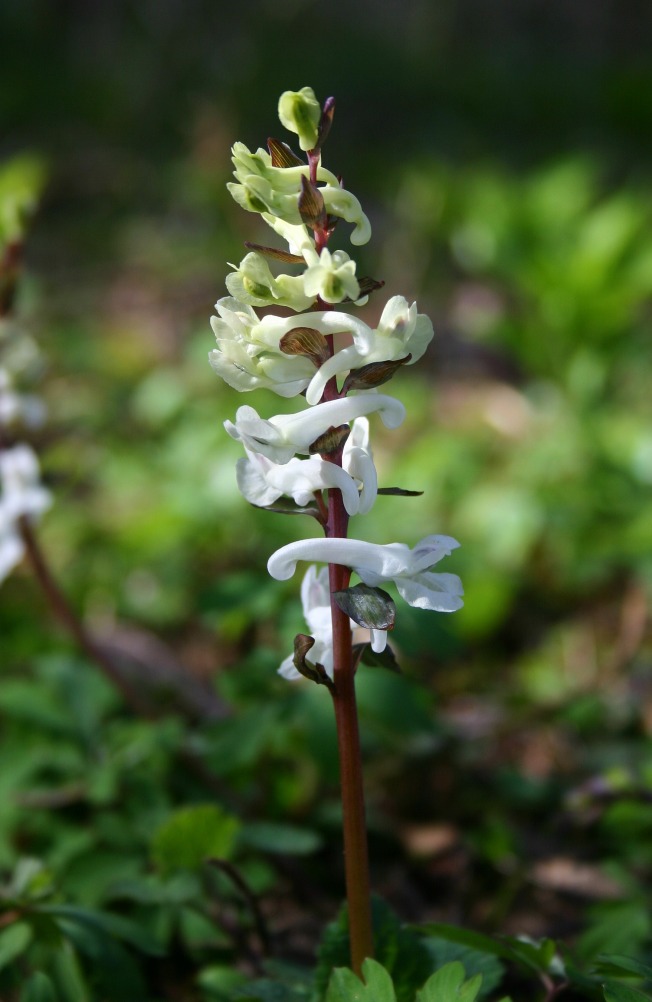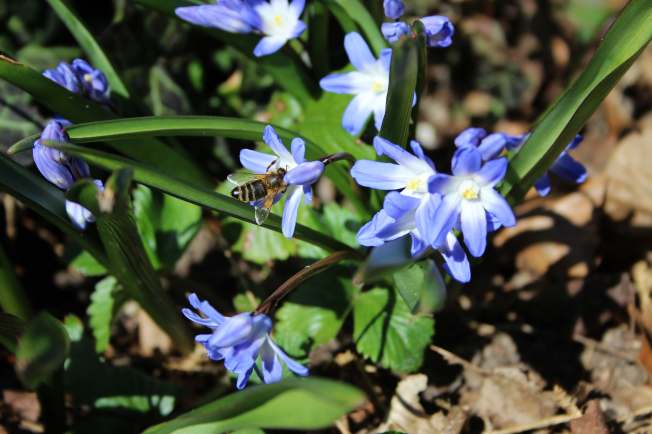Stinzenpflanzen – one of those nice long German words – is a new word for me. I came across it in my gardening magazine this month and thought it worthy of a mention here. I have been unable to translate it, as it seems to be a local term only, but I’ll do my best to explain…
“Pflanzen” is German for plants. And in northern Germany and the Netherlands “Stinzen” is an old Frisian word for houses made of stone… from the 16th century on this meant grand houses, for the wealthy only – manors and castles, houses on large estates, monasteries or vicarages, etc. These houses frequently had gardens and parkland attached, and as a sign of wealth and standing the grounds were planted extravagantly with bulbs, tubers and plants grown from rhizomes which had been introduced from other more exotic parts of the world by the plant hunters of the age, or simply from different regions of Europe.
Typical for this particular style of planting was spring flowering plants that naturalize, so in some areas of northern Germany the stone houses – “Stinzen” – have long gone, but areas of “Stinzenpflanzen” remain to remind us of the past.
The term Stinzenpflanzen includes flowers such as:
Snowdrops, Winter Aconites, Glory of the Snow…
… Spring and Summer Snowflakes, Scillas, Crocuses …
… Corydalis, Bluebells, Narcissi, the Snake’s Head Fritillary, Star-of-Bethlehem…
… Lily of the Valley, Arum Lilies and Wood Anemones…
Do you grow any Stinzenpflanzen?
😉








Plenty of Stinzenpflanzen around here, too! Thanks for the German lesson. 😉
* I love the corydalis and anemones, so delicate and lovely!
That corydalis was down near the river, and there are masses of them in pinks and purples too. 🙂
That must be something to see!
Beautiful photos and fascinating history. I never would have guessed the meaning behind “stone house plants”. Love the yellow wood anemone!
The yellow anemone was photographed a couple of years ago down near the river. A nice find!
Thank you for the history/German lesson and lovely photos. I only grow crocuses and narcissi at the moment, though id like to grow more of these flowers though 🙂 *makes a note* in gardening book 🙂
Crocuses are an excellent starting point as they are some of the first to flower. Have fun adding to your wishlist, Bec!
As a logophile I will definitely add this one to the lexigon. Thank you so much, I will hoard this one and try to use it. I am sure there is a word for a stinzenpflanzen ‘phile, although I may unable to pronounce it!
Lovely collection of photographs too.
I think most Germans probably haven’t heard of this word either Christine! I shall try and spread the word, so to speak, here too!
Well, I never knew that, I have never heard it before, but like so many German words it sounds great and sums things up in such a way that you just have to have it in your vocabulary. Yes, I have loads of Stinzenplanzen. Great to have a really good word for them. Obviously a word that has to be kept for private use or your friends would give you funny looks.
LOL! You could drop it into the conversation as if everyone should know what it means! 😉
Even I didn’t know the word Stinzenpflanzen, but I saw that I have nearly the same like you in my garden. Interesting story and lovely photos.
I think this word should be used more often! 🙂
I don’t know if I would agree to this, hehe. The word sounds like from a Charlie Chaplin film “the dictator” when he tries to speak German.
A most interesting post Cathy. I do indeed grow quite a few Stinzenpflanzen 🙂 It must be most rewarding to get beyond the stage of basic vocabulary when it comes to getting to grips with another language. I’m wondering how you pronounce the word. Is it a silent F? If not I’m not sure whether I could get my tongue round it 🙂
Hi Anna. Both the p and the f are pronounced… a bit of a mouthful, like many German words! I think this word is probably unknown to most Germans too, as it was explained in length in my magazine. The north and south of Germany differ immensely in terms of language too, so it may just be used up north.
There would be no hope for me if I had to say ‘Stinzenpflanzen’ then 🙂
Fascinating! I love learning something new, especially if it has to do with either words or plants. 🙂
I love words too, so having two languages at my disposal is a luxury!
New term for me too! 🙂 To answer your question: Scilla, crocus, snowbell and recently I´ve seen a white Corydalis cava too. 🙂 This afternoon we get some more needed rain!!!
We had a little rain overnight, but not enough! I thought this word might be more common in the north, but it seems it is a specialist term only.
Stinzenpflanzen are some of my favorites and I love the new word I can use to describe them. The corydalis cava looks right up my alley and I might have to search that one out now!
Good luck with finding a Corydalis cava. They grow in the damp woodland down near the river, in pinks and purples too, and I have never tried to grow one in the garden…. But my yellow Corydalis cheilanthifolia is doing well in a shady spot!
Great, if I’m trying to impress I can now say, “I love stinzenpflanzen, don’t you?” 🙂 Amelia
😉 Sounds really intellectual, being a foreign word! I think we should mention it all the time and see how long it takes for the English gardening programmes or magazines to catch on! LOL!
Yes, we grow loads of them, thank goodness we have Latin! I used to have Anemone ranuculoides but someone weeded it out thinking it was a buttercup!
I love seeing the yellow anemones, but they are rarer than the others. I was pleased to see a white one has appeared in my garden from the surrounding woods, and hope the hepatica will eventually spread too!
You´re right, it´s a local term – being from Southern Germany, I didn´t have a clue about the meaning of “Stinzen” either – until now! Thank you!
I think most northerners don’t know the word either Sabine! 😉 Thanks for visiting!
Interesting post and great photos!
Thank you, glad you liked the post!
Stinzenpflanzen – I love having plants that naturalize and come up new each year is the best! I love knowing the history words! Happy spring!
I also like to know where words come from, so having this word explained for me in my magazine was so great I just had to share!
I shall tell my daughter who is doing her German GCSE exams in a few weeks!
It’s probably one of those words you will never ever need in life but still manage to remember (at the cost of a more useful item of vocabulary)! Wish your daughter luck from me!
Beautiful photos Cathy. Looks sunny and perfect there.
We have had some lovely weather Susie. And the wind has finally dropped a little too. Looking forward to some rain tonight though!
What a great German lesson, Cathy!! Vielen dank. Your photos are just lovely. I’ve written ‘Stinzenpflanzen’ in my garden notebook. In our Midwest garden, the crocuses and scilla are finished, and the wood anenomes are coming into bloom this week. Such little treasures! ♡
The wood anemones are at their best here now too, but it has been so warm they won’t last much longer. Glad you enjoyed the lesson Dawn. 😉 And thanks for stopping by!
I think I do grow lots of Stinzenpflanzen which I hope will outlive me…beautiful and I loved the lesson!
That is a nice thought isn’t it…. something you have planted will last for generations to come…. Have a great week Donna!
That’s really interesting. How nice to be able to read the history of an area through its plants. We have a plant that we call Star of Bethlehem here but it is white and completely different to yours, I don’t remember it’s Latin name off hand.
I seem to remember I have seen a shrub pictured somewhere that is called star of bethlehem… I must have a search later!
All I have found is this small white flower: Ornithogalum umbellatum and other Gagea in the same family as mine. I am sure there is a shrub also known as Star of Bethlehem too, possibly only a local name though. Perhaps I’ll come across it again one day!